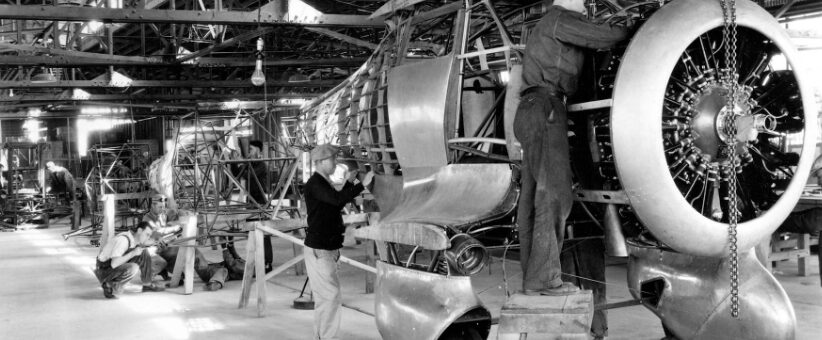
Amazing Staggerwing Aircraft from D-Day Is Now at the National Warplane Museum in Geneseo, NY
NY – The National Warplane Museum in Geneseo, NY has recently received a historic Staggerwing aircraft that was used on D-Day in 1944. The donated airplane has the serial number FT478 and a storied history. After it was built by Beechcraft, it was lent to Britain from the United States to help with the war effort. Of course, this wasn’t the only Staggerwing built. In total, Beechcraft built 781 C17Ls, and 200 of those airplanes are assumed to still exist. Staggerwing aircraft were beloved for their luxury and unique design. They were built from 1932 to 1948. Civilians used them for executive transportation and air racing. The military used them for a variety of purposes, including as bombers and transports. Let’s explore the Beechcraft C17L Staggerwing and why it was so revolutionary.
Beechcraft C17L Staggarwing or the Beechcraft Traveler Mk. I
The Beechcraft C17L was one of the first executive airplanes ever built, and it could officially carry up to five passengers. However, that number likely included the pilot. The Staggerwing had a length of 24 feet, five inches and a height of 8 feet, six inches, with a wingspan of 32 feet. Its top speed was 250 miles per hour, and it had a maximum gross weight of 3,165 pounds.
The Beechcraft C17L earned the nickname Staggerwing because the top and bottom wings were staggered. The bottom wing sat forward of the top wing rather than both wings being stacked perfectly vertically. This design improved the pilot’s visibility from the cockpit, positively helped the stall characteristics, and added to the aircraft’s overall appeal.
An Early Executive Aircraft
The Beechcraft C17L was built as an executive aircraft. It was meant to help businessmen and important people travel in comfort and ease. Needless to say, these airplanes were designed with luxury and comfort in mind. Many Staggerwings arrived at their new owner’s hangars with the latest avionics. Many of them had magnetos in their engines, and the interiors were often finished with leather and mohair to give them an exotic look and feel. Extremely wealthy executives could even choose from a list of upgrades and request custom paint schemes.
How Was the Beechcraft C17L Staggarwing Utilized During the WWII?
The Beechcraft C17L Staggerwing was an incredibly versatile aircraft, and they were used for a variety of tasks during WWII. The Spanish used the Staggerwing as a bomber. The British used the Staggerwing to transport personnel and to act as a liaison aircraft. In fact, the Staggerwing, which is now located at the National Warplane Museum in Geneseo, is the aircraft that was sent to Britain in 1944.
The FT478 Staggerwing was given to the British under the Lend-Lease Act. This act allowed the United States to supply war materials, including equipment, to allied nations before officially entering the war on December 8, 1941. Once the British received the aircraft, they renamed the Traveler MK.I, and it flew with two different squadrons during the war, including the 781 and 701. On D-Day, it flew a liaison sortie.
The FT478 Survived the War and Came Back to the US
Once WWII had concluded, the British returned the Staggerwing to the US, where it was decommissioned and sold in the civilian market. In fact, it changed hands numerous times during the next 50+ years.
Finally, it was purchased by Granger Haugh in the 1990s. He is a pilot, Navy veteran, and philanthropist. He flew the Staggerwing recreationally until 2007 when he donated it to the National Warplane Museum. The museum enjoyed it for a short time until the gear collapsed while taxiing, causing extensive damage to the warbird.
From Granger to the Museum Back to Granger
The damage to the Staggerwing was so extensive and expensive to repair that the National Warplane Museum opted to return the aircraft to Granger Haugh. Over the next several years, Granger had the historic warbird meticulously rebuilt and restored. Once the restoration was complete, Haugh didn’t send it back to the museum. Instead, he flew it to events, like Oshkosh, so that pilots and aviation enthusiasts could view and enjoy this piece of aviation history.
Most recently, Granger has decided to retire from flying. In the wake of that decision, he decided to donate the WWII Staggerwing back to the National Warplane Museum so that aviation enthusiasts can enjoy its unique appearance and storied history. We can also hope that this aircraft will be made available for airplane rides in the near future. If you’re interested in seeing this piece of history in person, you can visit the National Warplane Museum. In addition to the Staggerwing, they also have many other airplanes that you can view and enjoy and airplane ride. Those aircraft include a Whiskey 7, a Saigon Lady, a Flying Boxcar, a C-45 Expediter, a C-47 Dakota, and a Fairchild PT-26, among other aircraft.